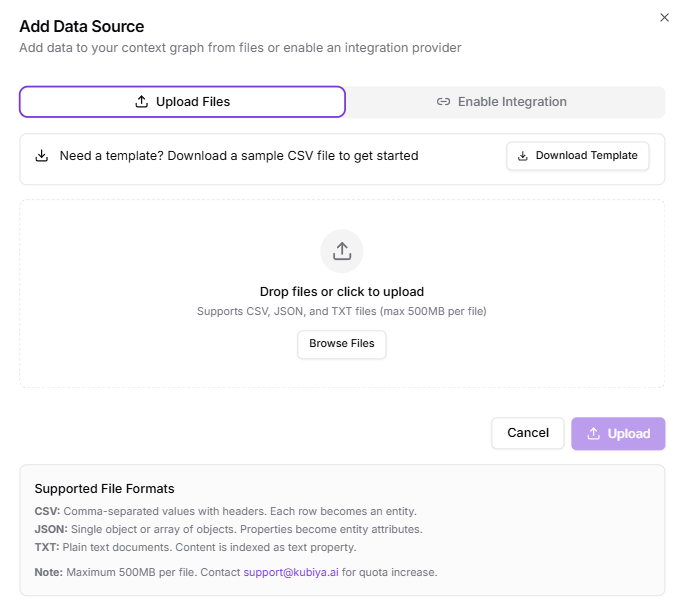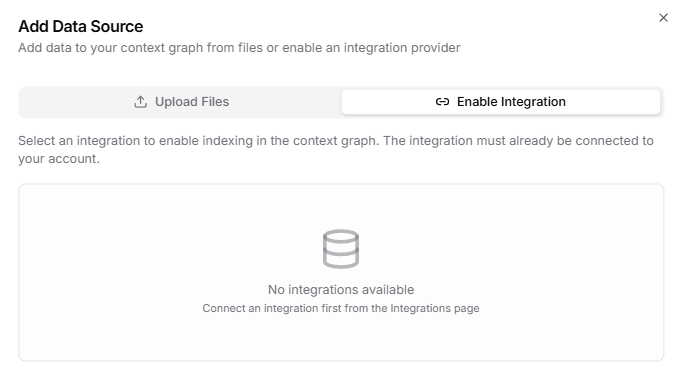
When to Use Data Sources
Add a data source when you need to:- Populate the Context Graph with new data
- Sync resources, identities, and configurations from an external system
- Upload structured datasets not available through integrations
- Enrich the graph with custom or ad-hoc data
- Refresh or expand existing graph data
Prerequisites
Before adding a data source:- Ensure you have access to upload files or enable integrations
- Confirm that any required integrations (AWS, etc.) are already connected in the Integrations page
- Prepare CSV, JSON, or TXT files if uploading manually (supports up to 500MB per file)
Key Concepts & Defaults
Active Integrations
Shows how many integrations are currently enabled for graph indexing.Total Entities
The number of entities already ingested and indexed in the Context Graph.Entity Types
Number of unique labels across all ingested entities.File Upload Ingestion
Each row (CSV) or object (JSON) becomes a graph node with properties created from the file’s fields.Integration-based Ingestion
When enabled, an integration continuously syncs backend resources into the graph.Add a Data Source
You can add new data through two methods:- Upload Files
- Enable Integration
1. Upload Files

Supported Formats
- CSV: each row becomes an entity
- JSON: single object or array; each becomes an entity
- TXT: contents indexed as a
textproperty - Max file size: 500MB per file
Supported Structure Examples
CSV template example:How to Upload Files
1. Open Add Data Source
Click Add Data Source on the Data Sources page.2. Select Upload Files
The modal opens on the “Upload Files” tab by default.3. (Optional) Download Template
Click Download Template to get a sample CSV file formatted for ingestion.4. Upload Files
You can either:- Drag and drop files into the upload box
- Click Browse Files to select them manually
5. Review Selection
Uploaded files appear in the list before submission.6. Click Upload
The system ingests the files and begins indexing entities into the Context Graph. Once complete, new entities will appear in:- Overview
- Graph Explorer
- Entities
- Queries
2. Enable Integration

Important Notes
- The integration must already exist in the Integrations page
- This modal does not allow adding or configuring integrations, only enabling indexing
- If no available integrations exist, the UI shows: “No integrations available — Connect an integration first from the Integrations page.”
How to Enable an Integration
1. Open Add Data Source
Click Add Data Source.2. Select Enable Integration Tab
Switch from “Upload Files” to Enable Integration.3. Choose an Integration
A list of connected integrations will appear (AWS, CSV, custom sources, etc.).4. Activate Indexing
Select the integration to enable ingestion into the Context Graph.5. Indexing Begins
Once enabled, the integration starts populating graph data automatically. Entities from integrations appear with source tags such as:IntegrationAwsIntegrationCsvIntegrationCustom
Verify & Troubleshoot
After uploading files or enabling an integration:To verify data ingestion
- Go to Entities and search for new items
- Open Graph Explorer to visually confirm new clusters or nodes
- Check Entity Types in the Data Sources page to see new labels added
If data does not appear
- Ensure the file format is supported
- Validate the CSV/JSON structure
- Confirm the integration is connected, not just enabled
- Check for file size limits (500MB max)
- Try re-uploading or reviewing ingestion logs (if supported in your environment)
Best Practices
- Use integrations whenever possible for continuous, structured syncing
- Keep CSV/JSON schemas consistent for predictable ingestion
- Use small test uploads before scaling to large datasets
- Store frequently used or shared datasets in integration sources rather than repeated manual uploads
- Review Entity Types to understand how new data is being labeled
What’s Next
After adding your data sources:- Explore Graph Explorer to visualize new relationships and structures
- Inspect entity details in Entities
- Run Cypher queries in Queries for deeper analysis
- Continue expanding your dataset with additional uploads or integrations
